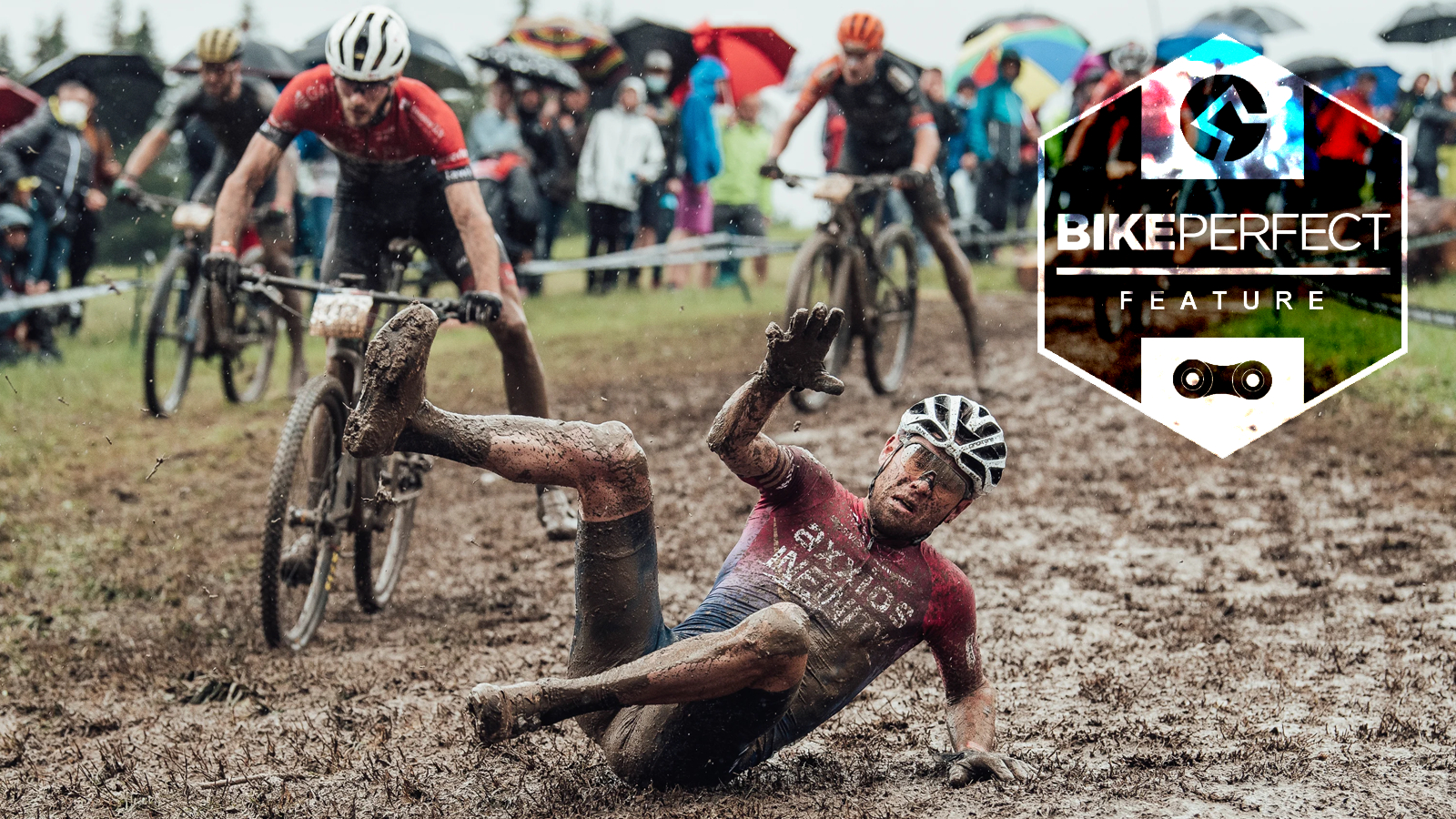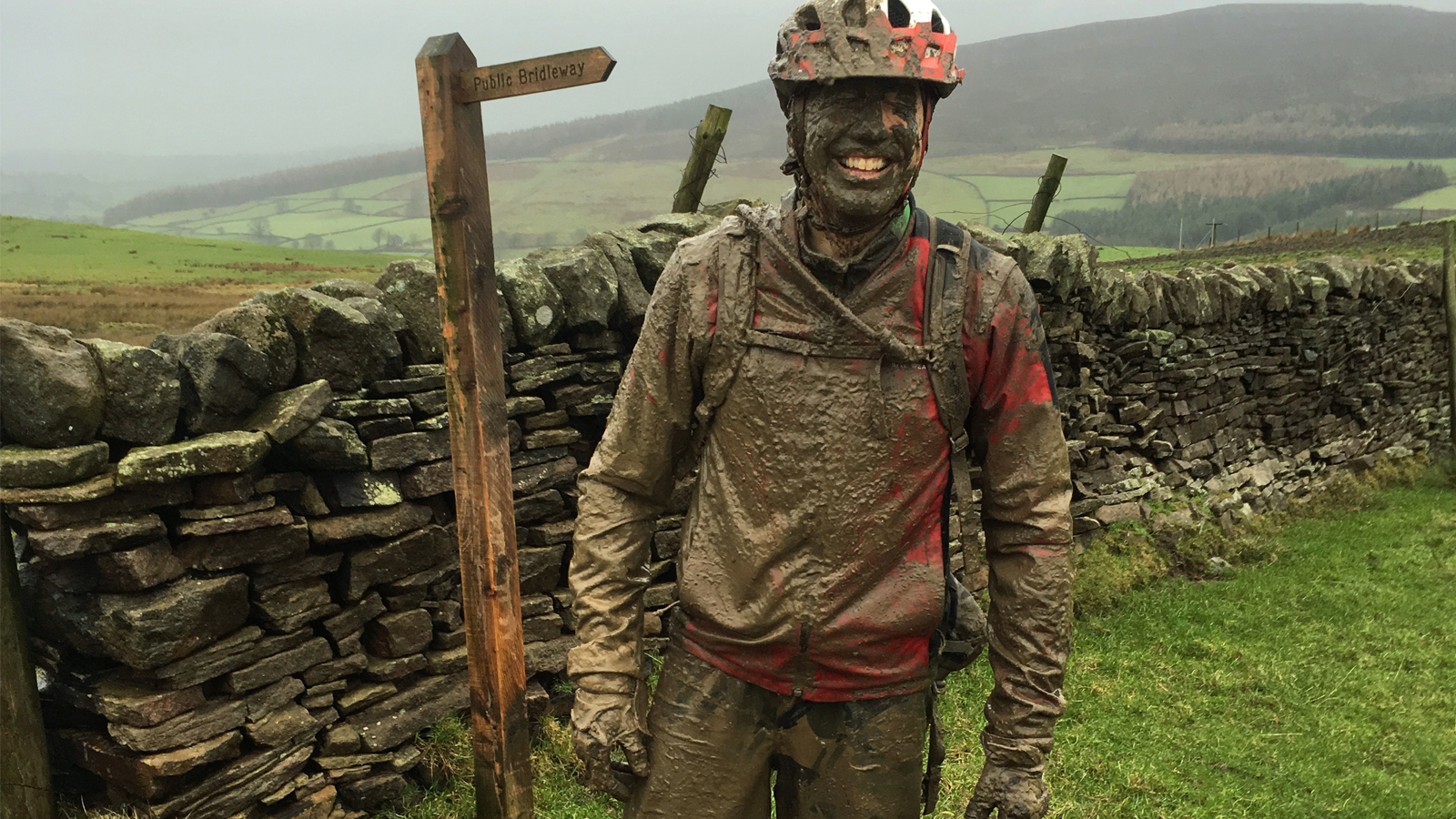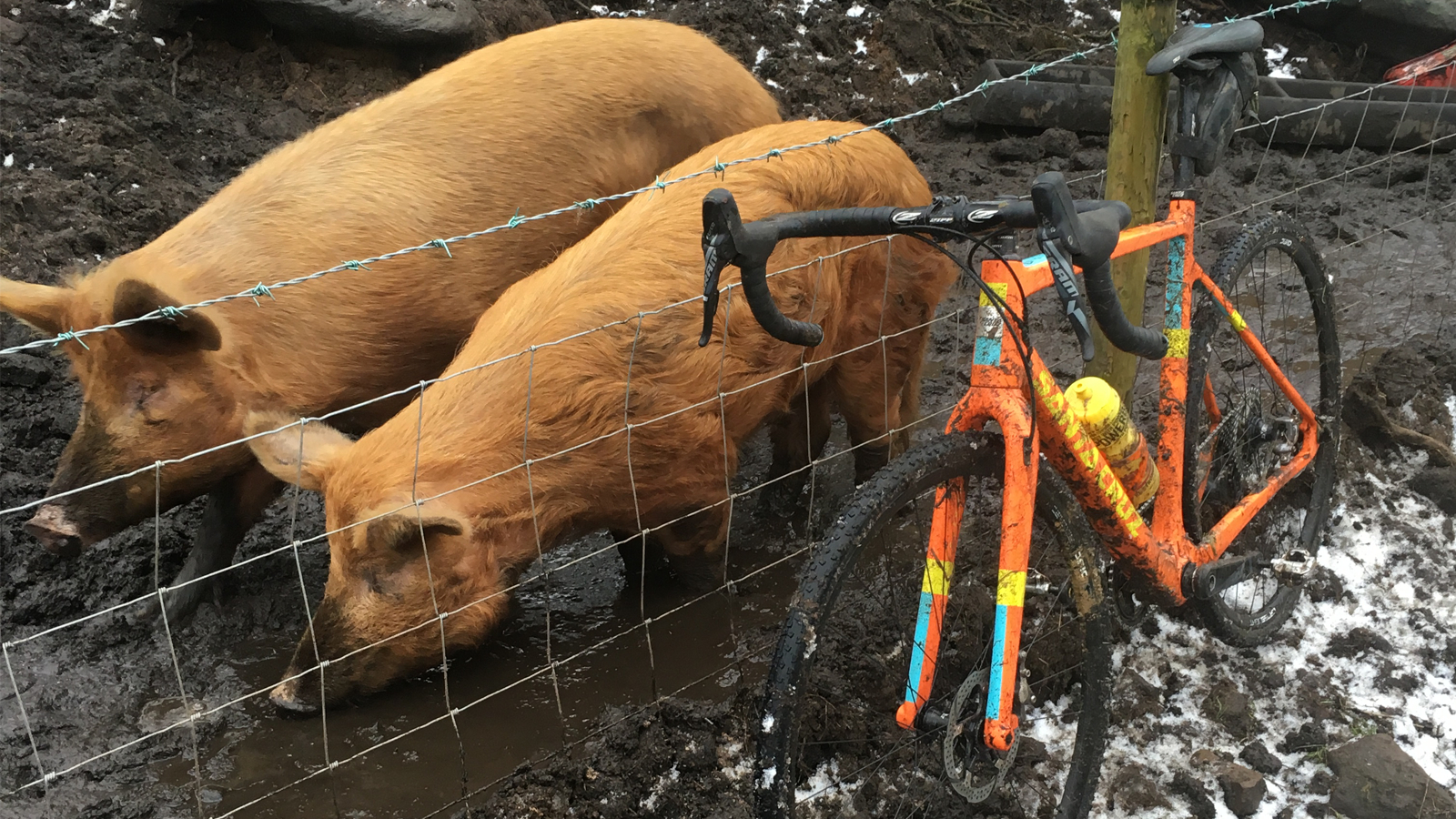Bespoken Word: Mud glorious mud
Guy Kesteven gets down and dirty about the reality of riding bikes through the slop

Mud has always been a problem for off-road bikers in the UK and while mountain bikers have learned to dodge it, it’s lying in wait for a whole new generation of gravel fans and lockdown-restricted MTBers. Guy Kesteven has been swamping for decades, so here’s a quick history of cycling filth and a few pointers to make you a god in the gloop, whether it’s an August Bank Holiday that would startle the Ark or you could only get time off work to tackle the Great North Trail in February.
So it’s summer here in the Northern Hemisphere and the trails are bone dry. Everyone is talking about the perils of sand traps or being the blind rider at the back of a dusty train, but when it turns wet in winter, we’ll just go a bit higher up the hills and ski instead for a few months.
- Cross-country mountain biking: everything you need to know
- Trail mountain biking: everything you need to know
I can remember realizing that’s what mountain biking - or any sort of off-road riding - was like for the majority of the world. Obviously, that came as quite a shock as a UK rider where riding year-round is effectively an amphibious activity, with no chance of escaping to another sport even when the snow comes. It was regularly reinforced as I started meeting more international product designers at launches too.
Being told by major tire brands that 'yes, we will get around to sorting out a soft compound mud tire at some point, but right now it’s more important that the semi-slick we sell tens of thousands of can survive being baked in the sun for months without degrading, than it is making a tire that we’ll sell a couple of hundred of and which will wear out in under a month in most countries'.
Plugging across the Yorkshire Dales with Trek top brass in the late '90s explaining that the scraping noise they can hear is their V brake pads vanishing within a ride and how their rims would soon become too thin to trust is a fond memory too. Interestingly Trek introduced its first trail MTB with disc brakes the following year.

In the same way that adapting to survive in fringe environments is what drives biological evolution, it’s been a very positive influence on mountain biking too. I’m not just talking about bigger disc brakes replacing rim brakes, or bikes getting larger tire clearances and better sealing on bearings. Over in Wales, forest ranger Dafydd Davies armored short sections of swampy trail with boulders, and borrowed some IMBA (International Mountain Bike Association, the US advocacy and trail building group) water runoff wisdom for aligning the traversing. The result were trails that didn't turn into rivers when it rained and the first all-weather UK MTB trail was born.
The dream of guaranteed good time riding rather than axle-deep, bike-killing bog trolling even in the mountains of Wales made it an instant success and similar trails started popping up everywhere. It had - and continues to have - a very interesting effect on bikes and kit too. UK trail tires used to be savage swamp spikes that would throw clogs of earth at the back of your head but drift terrifyingly on anything hard-packed. In fact, if you want a top, super niche trivia fact, the only way top BMX and dirt jump rider Steve Geall got such a superb cornering slide in the urban bike chase scene in 101 Dalmations was by running a set of Panaracer Spike mud tires. And I know that’s true because I was working for the Panaracer distributor at the time and I sent him the tires.
Soon though, tires like that were just gathering dust or having their teeth trimmed for better performance on man-made surfaces. Compound and carcass became more important than tooth length and we could even have conversations about tires and riding in general without it feeling like we were speaking a completely different language. There were still moments when our aquatic roots became clear - Danny Hart’s wild World Championship log flume run in Champery, 2011, being an obvious one. However as a whole generation of mountain bikers grew up only traveling to trail centers to ride, DH was about the only area people really ran specific mud tires for mountain biking.
Actually, I need to be clear here. I’ve fallen into the common trap of only focusing on the people that the media and manufacturers were putting their coverage and development emphasis on. There were still a ton of people going out riding wild trails all year round. Cutting through sludge on skinny tires with a nice big practical rear wheel guard keeping them clean and a bottle of oil in their pack to top up their chain regularly. They probably had a map on their bars and a change of clothes in case the weather turned or they fancied going overnight to really get out into the wild. And those clothes would be practical and potentially casual rather than covered in motocross style branding, and they’d be wearing waterproof socks, not knee pads and…….
Hang on a minute, these riders are sounding weirdly familiar and that’s why mud is suddenly becoming a relevant topic again. Because in the UK, ‘gravel’ is often more like gravy and I’m seeing exactly the same MTB issues of the early 90s mirrored in the drop bar dirt ‘revolution’.

The best “you shouldn’t really laugh” examples can be found on the forums of routes like Cycling UK’s King Alfred’s Way where you’ll find indignant posts about how difficult some sections were to ride after a week of heavy rain. How they’d fitted the fattest tires they could squeeze through the frame after doing their research on a gravel chatroom that has an IP address in Arizona and being gobsmacked that the wheels refused to revolve after 100m of clay and chalk ridgeway.
Distraught documentations of the shattering realization that their Zwift-honed FTP was absolutely useless when they couldn’t keep their bike pointing the direction they wanted or stop the wheel spinning on climbs. Ideally garnished by a sobbing statement that their desperate donuting had been utterly shamed by a grizzled old rider on a MTB from the last century. A grim reaper of ego and equipment choice, grinding past them arrow-straight on Lego compound, 1.5in Continental tires with his mahogany banister legs turning at about 25 RPM in a set of shorts that might have once been purple.
So here we are again, probably 25 years ago since I wrote my first article on riding in mud and maybe 20 years since I wrote my last (it was a particularly memorable one as a Malaysian pharmacy company asked the photographer if they could use the mud splash action shot that ended up on the cover of the mag), with me writing a quick primer on how to ride mud again.
- Best gravel bikes: drop bar off-roaders for racing and exploring
First thing to understand is that the best gravel bike tires are probably going to be shit in shit. That’s not a criticism, it’s just an acceptance that again, we’re the only idiot country who would classify a 30cm deep trough of slick chalk-sided slop or several kilometers of swamp on a moor top as ‘gravel’. Because most of the world thinks of gravel as small dry stones that you can speed over, even the tires that look promisingly mud-friendly like WTB’s Resolute or Pirelli’s Cinturato Gravel M won’t have side knobs you can trust or will be hard compound rubber so they roll okay on the road despite buzzing like a swamper truck. There are a few tires like Specialized’s Rhombus Pro, Vittoria’s Terreno Wet or WTB’s old Nano that work surprisingly well, but as they’re essentially old resized MTB or cyclocross tires they generally roll accordingly.
Speaking of cyclocross tires, their smaller sizing is not just a legal racing restriction but also because using a narrower tire for frame clearance and a deeper cut into the dirt works really well. Their reliance on super low ‘teen’ pressures for grip is also fine for racing around a park for an hour where the only tire-killing obstacles are a couple of planks someone always seems to have carelessly left across the course. That’s not going to work out so well under a laden bike being ridden all day in the wild where rocks and big roots are thumping off your rims. Lowering pressures slightly is still legit, however, as you’re likely to be going slower, which reduces high-speed impact incidents.
If you want to go low though make sure it’s a tough tire that stays on the rim and doesn’t rupture easily, rather than a skimpy race tire, and consider fitting a protective insert for stability and protection.
Guy's top tips for riding in the mud
Mostly the emphasis is on you the rider, so here are a few riding tips to help you through the worst conditions, whether you’re a gravel grinder or we all get locked down again and you have to ride your MTB on muddy local trails.
1. Go straight and go wet
The obvious temptation is to dodge around puddles and slop, but turning your front wheel is exactly when it’s going to slide or get grabbed by ruts and twist right round. Riding around puddles just widens the mess too, so it's very bad from an environmental point of view. Instead, pick a line through the wettest section (where the mud is the sloppiest and offers the least resistance to progress) and hold it straight by keeping your head high and looking at the far side. Wet mud/running water also gives the least rolling resistance and cleans off tires fastest so they grip again, so it’s a win that way too.
2. Get low and get back
Mud loves grabbing front tires and trying to send you over the bars. To stop that, push back so the front wheel skims rather than sticks, and you have more weight and traction on the rear tire. Pushing back reduces the chance of getting launched over the bars too, so on steep descents if you can drop your saddle or just get your belly on it, do it.
3. Back brakes and big gears
If you know how ABS (anti-lock braking system) works in a car you’ll realize that a rolling tire gives you much more directional control and traction than a sliding one. That means staying off - or at least being very light on - the front brake is crucial for control. In contrast, a trailing rear wheel can act like a kite tail to stabilize the bike, but again if you can keep it rolling, your grip and control will be a lot better. Factor in the way mud slows you down and you might not even need to brake at all, which also leaves arms looser and more relaxed for an instant response to slides.
If you’re climbing or charging through thick, sticky mud, then go big on the gear. That gives you much better feedback for feathering traction and because revs are lower and torque higher, you’re less likely to spin the wheel (just like driving in second gear rather than first in snow). For extra grunt and grip, twist your bars backwards to force the rear wheel into the ground and pull back hard with each pedal stroke to create maximum drive and ‘dig in’ effect. Commit to the gear you start in too, as trying to change under load is a guaranteed derailleur and/or chain killer, and right now you might not get another one until 2025.
4. Keep it clean
It might be tempting to let mud pile up for the ultimate ‘look how bad it was' Insta shot but it’s a really bad idea. Muddy tires and jammed frames massively increase strain on clogged chains that will skip and grind themselves into swarf at a scary rate, wedging behind chainrings or pick up sticks that will rip off rear mechs before you can backpedal. We’ve already mentioned riding through the wet bits and puddles to rinse off filth but use any stop opportunity to get stuck in with sticks or fingers and free your bike up as much as possible. Take a small bottle of lube for when things start squeaking or grinding too.
5. Enjoy the challenge
This final tip isn’t technique but staying positive is probably the most important skill to take into your fight with filth. If you can embrace the basic stupidity of sliding about in a mud bath, spinning out, falling on your arse and looking like a vet that’s just manually cleared a constipated cow, then you’re winning however far and fast you get. Getting angry and frustrated will just make you stiff and tie you up, when staying loose and responsive is the key to progress. It’ll also keep you limited on ‘acceptable’ routes and weather options - or even worse hiding on the couch entirely - when you could be out as happy as a proverbial pig in muck.

Guy Kesteven has been working on Bike Perfect since its launch in 2019. He started writing and testing for bike mags in 1996. Since then he’s written several million words about several thousand test bikes and a ridiculous amount of riding gear. He’s also penned a handful of bike-related books and he reviews MTBs over on YouTube.
Current rides: Cervelo ZFS-5, Specialized Chisel, custom Nicolai enduro tandem, Landescape/Swallow custom gravel tandem
Height: 180cm
Weight: 69kg
